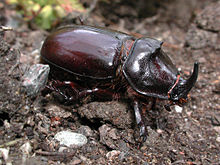horn

Horn is the name given to the outgrowth on the head of the horn-bearers and rhinos . In a figurative sense, similar structures on the body of other animals are also referred to as "horns".
etymology
The common Germanic word mhd. , Ahd. Horn is, such as B. also the Latin cornu , a formation of the idg. Root * ker [ə] - "horn", "antler", to which the words brain and deer as well as Latin cervus go back.
Horn in the real sense
The Horn of Bovidae (Bovidae), a family of ruminants , which include antelopes , cattle , sheep and goats belong, is a hollow coating over a bone pin which is covered with a well-vascularized skin layer. In contrast, there is the deer family (Cervidae), which has antlers made of bone and not horny substance. In contrast to antlers, horns grow a lifetime.
The horn of the rhinoceros is a solid outgrowth made of glued bristles . It can be cut back just as painlessly as hair or fingernails - a measure that is used in animal welfare , since rhinos are hunted almost exclusively for their horns: a rhinoceros whose horn has been removed is worthless to poachers.
Horns are used as both a container and a musical instrument .
Outgrowths from other body substances
In the hunter language , antlers are called "horns". However, the deer's antlers are not made of horn, but of solid bone substance.
Rather, the "horn" of narwhals is a tusk .
In other animal groups, too, for example some beetles , one speaks of horns for analog appendages; in insects , these are formed from chitin as part of the exoskeleton .
Horn in the phrase
The saying "to put horns on someone" comes from the practice of grafting spores that have been cut from their feet into capons through a wound on their head. There they may not only grow in, but also become larger than their feet would have become: the castrated rooster, i.e. the capon, can be recognized by the "horns".
Horn in the name
Names of living beings usually have the addition of horny if they are characterized either by sharp, hard protrusions on the head or by the possession of very hard substances in the outer skin:
- Mammals: horned bearers (plus the legendary unicorn ), rhinoceros
- Birds: hornbill
- Dinosaur: Triceratops (literally "three-horned face")
- Reptiles: horned viper (name for some species of snakes)
- Amphibians: horned frog
- Fish: garfish
- Insects: horn flies , moon horn beetles , rhinoceros beetles
- Arachnids: horn mites
- Cnidarians: horn corals
- Mushrooms: horns
- Plants: horn leaf , horn clover
See also
Web links
Individual evidence
- ^ Friedrich Kluge , Alfred Götze : Etymological dictionary of the German language . 20th edition. Edited by Walther Mitzka , de Gruyter, Berlin / New York 1967; Reprint (“21st unchanged edition”) ibid 1975, ISBN 3-11-005709-3 , p. 316 ( Horn ) and 310 ( Hirsch ).
- ^ The dictionary of origin (= Der Duden in twelve volumes . Volume 7 ). 5th edition. Dudenverlag, Berlin 2014 ( p. 390. ). See also DWDS ( "Horn" ) and Friedrich Kluge : Etymological dictionary of the German language . 7th edition. Trübner, Strasbourg 1910 ( p. 213. ).



